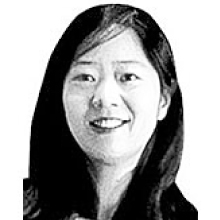‘Shut up and go anti-Japanese’

The author is an editorial writer at the JoongAng Ilbo.
Amid all the excitement over “Avengers: Endgame,” another movie opened quietly. It was the 2016 film “Tadao Ando — Samurai Architect,” a documentary about a 77-year-old architect, a high-school graduate and former boxer who won the Pritzker Prize in 1995. After visiting Chichu Art Museum in Naoshima, Japan, and Ilmin Museum on Jeju Island, I thought I knew a lot about Ando. But I was quite shocked after watching the movie last weekend. His status was greater than what I realized, not just in Japan but in Europe as well. Ando, not some European architect, was commissioned to renovate the Punta della Dogana, an art museum in Venice which was built in 1677.
Ando is an outstanding figure, yet the commission was based on Europeans’ admiration for Japan. The brand of Japan is combined with Ando’s name to maximize the charm.
In fact, it is no news that the Western world loves Japan. In German writer Hermann Hesse’s “Demian” — a must-read for young people and well-known as an inspiration for BTS — “a short Japanese man” appears as Demian’s friend, showing Hesse’s love for Japan. There are countless contemporary European intellectuals and artists charmed by Japan. Vincent van Gogh and other European artists in the 19th century were known to be influenced by Japanese woodblock prints, or ukiyo-e.
The West’s love for Japan is not merely in the past. It is expanding from culture to industry, from Europe to the United States. It is not an exaggeration to say that founders of Blue Bottle Coffee — which opened in eastern Seoul last weekend and had people lining up for hours — were fascinated by Japan and put Japanese soul into their products. Started in California, Blue Bottle Coffee is a premier coffee chain that turned Japan’s tea ceremony and cafe culture into a brand. Apple owes a lot to Japan as well. Its simple designs illustrate how Steve Jobs was into Japanese Buddhism.
In short, Japan captivated people around the world with cultural depth and amazing artisanship. But through the prism of Korea, Japan becomes a completely different country. Due to an old grudge that can never be shaken off, Koreans portray Japan as a nation of savages far beneath Korea’s high cultural standard. It would be nice to turn a blind eye, but distortions are made to belittle Japan.
Here’s how it’s done. Before the centennial of the March 1, 1919, Independence Movement — the same year that Hesse featured a short Japanese man in “Demian” — prominent Korean history lecturer Seol Min-suk appeared on a television variety show and condemned Japan’s damage to the Seokguram Buddha and its grotto in Gyeongju, North Gyeongsang. “Seokguram was the epitome of mathematics, geometry and science and was preserved for more than 1,000 years, but Japan was jealous and damaged it with cement and concrete,” he said. But the record tells us something different. When Japan’s reconstruction began in 1912, Seokguram’s ceiling had fallen and was filled with soil. I could easily tell from photographs that it was on the verge of collapse. Japan did its best to save the cultural asset by using the latest technology at the time, which was cement. After the broadcast, Japan was criticized by the Korean public as a savage nation that was blinded by jealousy.
When a clear distortion of history is easily revealed, you would expect a correction. I’ve never heard the lecturer or the broadcaster apologize or stand corrected. In fact, I am not very surprised. In Korea, the idea “Shut up and go anti-Japanese” has always been exonerated.
However, I cannot treat lecturer Seol’s Seokguram remarks as simply part of a variety show because the anti-Japanese sentiment is excessive in the Moon Jae-in administration, with broadcasters at the forefront. In his speech for the centennial of the March 1st Independence Movement, Moon said, “The Red and commie theories are typical vestiges of Japanese collaborators that Korea must overcome soon.”
How is our negligence of facts and “spiritual victory” different from the misjudgment of Joseon Tongsinsa, which led to the worst war since the founding of the Joseon Dynasty (1392-1910)? In 1592, Hwang Yun-gil, head of the delegation to Japan, suggested that Joseon needed to prepare for a Japanese invasion. But having seen the same things in Tokyo, Kim Sung-il blurred King Seonjo’s judgment by saying, “Because Toyotomi Hideyoshi had the eyes of a rat, there’s nothing to fear.” As we all know, the people had to pay a high price.
“Shut up and go anti-Japanese” may be good for domestic politics, but it has pulled the nation into a crisis. Ever since we suffered the Japanese Invasion of 1592, we haven’t gained the simple common sense to look at the facts as they are.










with the Korea JoongAng Daily
To write comments, please log in to one of the accounts.
Standards Board Policy (0/250자)